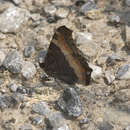Conservation Status
provided by University of Alberta Museums
Not of concern.
- license
- cc-by-nc
- copyright
- University of Alberta Museums
Cyclicity
provided by University of Alberta Museums
One, or possibly two generations per year, usually found in early spring and again in late summer.
- license
- cc-by-nc
- copyright
- University of Alberta Museums
Distribution
provided by University of Alberta Museums
Alaska south to California and New Mexico, east to New England and Newfoundland (Layberry et al. 1998, Opler 1999).
- license
- cc-by-nc
- copyright
- University of Alberta Museums
General Description
provided by University of Alberta Museums
The solid black wing bases edged with bright yellow and orange are unmistakable. Our populations are the nominate subspecies.
Recent work by Nylin et al. (2001) shows that Milbert's Tortoiseshell is more appropriately placed in the genus Aglais.
- license
- cc-by-nc
- copyright
- University of Alberta Museums
Habitat
provided by University of Alberta Museums
Found in many habitats, from prairie coulees to boreal forests and mountain tops.
- license
- cc-by-nc
- copyright
- University of Alberta Museums
Life Cycle
provided by University of Alberta Museums
The conical eggs are green with eight or nine vertical ridges (Guppy & Shepard 2001). Small larvae live communally in silken nests on the hostplant. Mature larvae are solitary, and are black with yellowish subdorsal lines, finely dotted with white, and bear branched spines (Layberry et al. 1998). This tortoiseshell is encountered much more regularly than other tortoiseshells in Alberta, apparently since it does not experience the large fluctuations in number that occur in the California and Compton Tortoiseshells. Adults are strong, rapid fliers but are easily approached when nectaring at flowers. Milbert's, like its other close relatives, overwinters as an adult, emerging early in the spring with faded and often tattered wings. The offspring of the hibernators appear from July onward. Bird et al (1995) state that there are two generations annually, but this needs confirmation; multiple generations in Canada are known only from southeastern Ontario (Layberry et al. 1998).
- license
- cc-by-nc
- copyright
- University of Alberta Museums
Trophic Strategy
provided by University of Alberta Museums
The larvae feed on stinging nettle (Urtica dioica) in British Columbia (Guppy & Shepard 2001) and in Alberta (D. Lawrie, unpubl. data). Unlike other members of the 'hibernator' group, adults of this species are avid flower visitors, but will also visit tree sap or rotting fruit.
- license
- cc-by-nc
- copyright
- University of Alberta Museums
Aglais milberti
provided by wikipedia EN
Aglais milberti, the fire-rim tortoiseshell or Milbert's tortoiseshell, is considered the only species of the proposed Aglais genus that occurs in North America.
Description
The wingspan is between 4.2 and 6.3 cm and the forewing's tips are squared off. The upperside is black with wide orange submarginal bands; this orange slightly fades to yellow near the inner edge. Both wings have narrow black marginal borders; the hindwing may have blue spots.[2]
Behaviour
This is a quick species that flits rapidly around woodland roads. When it lands it may open its wings, often on trees or rocks.
Range and habitat
Milbert's tortoiseshell's range includes all of Canada and Alaska south of the tundra, all of the western United States and most of the eastern United States. In these areas they commonly occur in wet areas, including moist pastures, marshes, most trails, and roadsides.
Life cycle
There are two broods from May to October. During this time adults mate and lay eggs. The female will lay her eggs in bunches of up to 900 individuals on the underside of the host plant's leaves. Early-instar caterpillars eat together in a web, but later instars feed alone. They hibernate as adults, often in small congregations. Adults have been known to mate in low-elevation watercourses in arid regions.
Larval foods
Adult foods
References

- license
- cc-by-sa-3.0
- copyright
- Wikipedia authors and editors
Aglais milberti: Brief Summary
provided by wikipedia EN
Aglais milberti, the fire-rim tortoiseshell or Milbert's tortoiseshell, is considered the only species of the proposed Aglais genus that occurs in North America.
- license
- cc-by-sa-3.0
- copyright
- Wikipedia authors and editors

